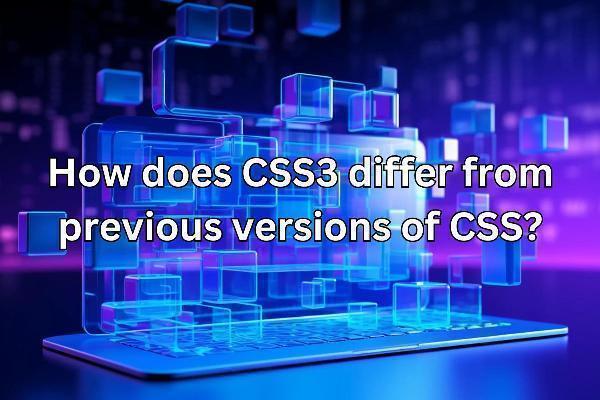How does CSS3 differ from previous versions of CSS?

Strong 8k brings an ultra-HD IPTV experience to your living room and your pocket.
Introduction
CSS3, the latest iteration of Cascading Style Sheets, represents a significant evolution from its predecessors. Unlike earlier versions, CSS3 introduces numerous advanced features such as rounded corners, gradients, animations, and media queries, allowing for more sophisticated and responsive web design. It offers greater flexibility, enhanced styling capabilities, and better support for modern browsers, empowering developers to create more visually appealing and interactive websites.
What is CSS?
CSS, short for Cascading Style Sheets, is a fundamental technology used in web development to control the presentation and layout of web pages. It works alongside HTML (Hypertext Markup Language) and JavaScript to define how HTML elements are displayed on a screen, including their colors, fonts, spacing, and positioning.
What is CSS3?
CSS3 is the latest evolution of the Cascading Style Sheets (CSS) language, a cornerstone technology of the World Wide Web. It builds upon the foundations laid by its predecessors, CSS1 and CSS2, introducing new features, capabilities, and improvements that enhance the styling and layout of web pages.
Here’s a Detailed look at How CSS3 Differs from previous versions of CSS:
1. Modular Structure
Previous Versions:
CSS2 was a single, large specification that included all the features and capabilities in one document.
CSS3:
CSS3 is divided into multiple modules, each focusing on a different aspect of web design. This modular approach makes it easier for developers to learn and implement specific features without having to deal with the entire specification at once. Examples of modules include Selectors, Box Model, Backgrounds and Borders, Text Effects, 2D/3D Transformations, and Animations.
2. Enhanced Styling Capabilities
Backgrounds and Borders:
CSS3 provides more control over backgrounds and borders. For instance, it allows for multiple background images, background clipping, and border images. This flexibility enables more complex and visually appealing designs.
Text Effects:
CSS3 introduces new text effects such as text shadows, text overflow handling, and word wrapping. These features help improve the readability and aesthetics of text content on web pages.
3. Advanced Selectors
Previous Versions:
CSS2 had a limited set of selectors, which made it challenging to target specific elements based on complex criteria.
CSS3:
CSS3 introduces a wide range of new selectors that allow for more precise targeting of elements. These include attribute selectors, pseudo-classes, and pseudo-elements. This means developers can apply styles based on attributes, element positions, and states, leading to more dynamic and responsive designs.
4. Layout Improvements
Flexible Box Layout (Flexbox):
CSS3 introduces Flexbox, a powerful layout model that makes it easier to design flexible and responsive layouts. Flexbox allows elements to be aligned and distributed within a container, even when their size is unknown or dynamic.
Grid Layout:
CSS3 also includes the Grid Layout, which provides a two-dimensional grid-based layout system. This is particularly useful for creating complex web page layouts without relying on floats or positioning hacks.
5. Animations and Transitions
Previous Versions:
CSS2 did not natively support animations or transitions, requiring developers to use JavaScript for such effects.
CSS3:
CSS3 introduces built-in support for animations and transitions. Transitions allow smooth changes between different states of an element, such as changing the background color or moving an element from one position to another. Animations enable more complex sequences of keyframe-based animations, allowing for intricate visual effects without relying on external scripts.
6. Media Queries and Responsive Design
Previous Versions:
Designing for different screen sizes and devices was challenging and often required multiple versions of a website.
CSS3:
CSS3 introduces media queries, which enable responsive design by applying different styles based on the characteristics of the device, such as screen width, height, resolution, and orientation. This allows developers to create a single website that adapts to various devices, providing an optimal viewing experience for users on desktops, tablets, and smartphones.
7. New Color Models
Previous Versions:
CSS2 supported basic color models such as hexadecimal and RGB.
CSS3:
CSS3 adds new color models, including RGBA, HSLA, and HSL. These models offer more flexibility and control over color transparency and representation, allowing for richer and more nuanced color schemes in web design.
8. Improved User Interface Features
Box Sizing:
CSS3 introduces the box-sizing property, which makes it easier to manage the sizing of elements. This property ensures that padding and borders are included in the element’s total width and height, simplifying layout calculations.
Multiple Column Layout:
CSS3 includes support for multiple column layouts, making it easy to create newspaper-like columns of text with minimal effort.
Conclusion
CSS3 represents a significant leap forward in web design capabilities compared to previous versions of CSS. Its modular structure, enhanced styling options, advanced selectors, improved layout techniques, support for animations and transitions, media queries, new color models, and user interface features make it a powerful tool for modern web development. By leveraging these new features, designers and developers can create more dynamic, responsive, and visually appealing web pages that provide a better user experience across a wide range of devices.To mastering CSS3 and other essential web development technologies, consider exploring Full Stack Web Development Course in Indore, Gurgaon, Nashik, Agra, and other cities across India. These courses provide comprehensive training that includes CSS3 alongside HTML, JavaScript, backend development, and more, equipping you with the skills needed to succeed in the rapidly evolving field of web development.
FAQs on How CSS3 Differs from Previous Versions of CSS
1. What is CSS3?
CSS3 is the latest version of the Cascading Style Sheets (CSS) language, which is used for styling and designing web pages. It introduces new features and improvements over previous versions, making web development more powerful and flexible.
2. How is CSS3 structured differently from previous versions?
Modular Structure:
Unlike CSS2, which was a single, large document, CSS3 is divided into modules. Each module focuses on a specific aspect of styling, such as Selectors, Backgrounds, and Borders, allowing developers to learn and implement features independently.
3. What new styling capabilities does CSS3 offer?
Enhanced Backgrounds and Borders:
CSS3 allows for multiple background images, background clipping, and border images, providing more design flexibility.
Text Effects:
New text effects like text shadows, text overflow handling, and word wrapping enhance the visual appeal and readability of text content.
4. How do CSS3 selectors differ from those in previous versions?
Advanced Selectors:
CSS3 introduces new selectors, including attribute selectors, pseudo-classes, and pseudo-elements. These allow for more precise targeting of elements based on attributes, positions, and states, enabling more dynamic designs.
Note: IndiBlogHub features both user-submitted and editorial content. We do not verify third-party contributions. Read our Disclaimer and Privacy Policyfor details.


